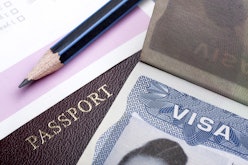Here’s How Long U. S. Citizens Can Stay In Every European Country Without A Visa
Here’s How Long U.S. Citizens Can Stay In Every European Country Without A Visa

So you loved your Euro trip so much you don’t ever want to leave, and you find yourself wondering how long you can stay in Europe without a visa if you’re a U.S. citizen. Or, you’re considering a long distance relationship and want to map out the possibility of love based the possibility of your visits. Either way, you’re not alone. The search terms alone for “how to stay in Europe as a U.S. citizen” yields thousands of results. And while there’s a lot of information out there about visa rules and restrictions, the verbiage is incredibly complicated and can vary from country to county. And with fines and deportation at stake, it’s not something you really want to guess-timate. So, here are the rules:
Schengen Area
Though sometimes we refer to Europe as a singular unit, not every country within the EU operates the same, especially when it comes visas and travel restrictions. Included in the Schengen Area, aka the 26 countries within Europe that do operate as a single unit, are:
You can move freely between any of those countries as if they were one mega unit, as they all share the same border policies and essentially consider you, the American, a traveler of any or all of those countries once you first enter the Schengen Area. If you want to visit any of those countries without a visa, you’ll have to leave after 90 days — and that time limit does not restart when you enter a different country, because they are all in the Schengen Area. So, for instance, if you enter Europe via Portugal, then you spend 30 days there before moving on to, say, Spain, you have 60 more days before you need to leave the Schengen Area. Then, you must leave the Schengen Area for 90 days — after that, you can return for another 90 days.
Non-Schengen Area Countries
However, though this is the standard rule, this isn’t always the case. If you travel to a non-Schengen member country in Europe, like the United Kingdom, there are different rules: In the U.K., for instance, you can stay for up to 180 without a visa. Conversely, in Belarus, you can only stay for 30 days without a visa.
Again: Though you can only stay in the Schengen Area for 90 days, those days are counted only within a 180 day period. In other words, every six months, your travel allowance is reset, and you get 90 more days. So, theoretically, if you wanted to stay in Europe for more than 90 days, you could pop over to the UK, a non-Schengen country, spend 90 days, and then go right back in, via the Schengen Area.
Schengen Area Countries That Agreements With The U.S.
Now, loopholes: The following countries have something called a “bilateral agreement” with the United States:
These agreements mean that U.S. citizens are able to stay an additional 90 days in those countries without a visa. In order to take advantage of this, you have to fly directly from a Schengen Area to one of those countries and stay put for those 90 days. Or, you can stay in one of those countries for 180 days.
During that time you can’t work or leave, and according to many message boards for travelers who have utilized this loophole it’s technically up to border patrol to decide whether or not to allow you to stay for the additional time, as there have been efforts recently to revoke the rule — so don’t make plans without checking with the embassy and the border.
Whatever you do, make sure that you abide by the restrictions diligently, as you will be subject to a fines and deportation. In some cases, you can even be banned from future travel in the Schengen countries, so if the goal is to spend more time in Europe, following the rules is going to make it easier for you to do so.
Which countries do not need a visa to travel to Europe?
This website does not belong to, nor is it affiliated with, the EU. The official website of the European Union is europa.eu.

Over more than 50 countries do not need a visa to travel to Europe, specifically the Schengen Area.
For visa-free countries, the European Union will launch the European Travel and Information Authorisation System (ETIAS) in November 2023.
ETIAS is not a visa, it is an electronic travel authorisation that can be easily obtained through an online application.
Through the system, visa-exempt foreigners will need to get an ETIAS to visit Schengen countries for stays of up to 90 days.
Although ETIAS will become a new entry requirement for Schengen countries, it will only take travellers a few minutes to complete the registration. Most applications should be approved shortly after they have been submitted.
Nationals from the following countries are eligible to apply for ETIAS and visit Europe without a visa:
Country of origin of the traveller to Europe
Which countries can I visit in Europe without a visa?
If you are from one of the countries listed above, which have a visa-free agreement with the EU, you may visit the Schengen Area without a visa for short term stays.
However, please note that not all European member countries are part of the Schengen zone. The Republic of Ireland, for instance, is not a Schengen member country.
What countries are in the Schengen Area?
The Schengen Area is made up of European nations that have abolished controls at their shared external borders.
There are 22 EU member countries, 4 member countries of the Free Trade Association, and 3 micro-states in the Schengen Area.
Nationals from countries that do not need a visa to travel to Europe will have to apply for an ETIAS travel authorisation, starting in November 2023.
ETIAS will also be a requirement to travel to Member States that have not yet fully adopted the Schengen Agreement. These include:
Third-country nationals who are not visa-exempt need a Schengen visa to enter the Schengen zone.
To visit countries outside Schengen, it is necessary to contact an embassy. For instance, to enter the United Kingdom, foreigners must meet the respective entry requirements.
How to travel to Europe without a visa
To travel to Europe without a visa, you need a passport with a minimum validity of at least 3 months beyond the period of your expected stay in the region.
However, be sure to check that you are from a visa-free country before booking your trip.
Additionally, all foreign visitors are advised to get travel or health insurance in case of an emergency.
Schengen Area countries do not require foreign visitors from visa-exempt countries to have a visa. However, EU countries that are not Schengen members have their own entry requirements.
Which European countries are not in Schengen?
The European countries that are not part of the Schengen zone are:
- Albania
- Armenia
- Azerbaijan
- Belarus
- Bosnia & Herzegovina
- Bulgaria
- Croatia
- Cyprus
- Georgia
- Ireland
- Kosovo
- North Macedonia
- Moldova
- Montenegro
- Romania
- Russia
- Serbia
- Turkey
- Ukraine
- United Kingdom
These European countries have their own specific visa requirements which may differ from Schengen regulations. However, ETIAS will be a requirement for incoming Schengen members such as Croatia, Cyprus, Bulgaria and Romania by November 2023.
Which visa-free countries will need the ETIAS travel authorisation?
The countries that will need an ETIAS travel authorisation are the countries exempt from a visa to travel to the Schengen Area.
A citizen from one of the eligible countries will simply need an Internet connection and a computer, mobile, or tablet to complete the ETIAS online form.
Eligible travellers should meet the ETIAS requirements before completing the form. To successfully get ETIAS, applicants need a valid passport, an email address, and a debit or credit card to pay the ETIAS fee.
To complete an ETIAS application, travellers must provide their personal information, travel details and passport information.
Each applicant must answer a series of security questions related to their health status, criminal background and if they have visited conflict zones in recent years.
It is expected that most ETIAS applications will be processed in a matter of minutes.
However, in some cases, some ETIAS applications might be processed manually to verify the accuracy of the traveller’s data.
All the information provided by a traveller is contrasted with international security databases and the Schengen Area.
Who needs to get the ETIAS visa waiver to travel to Europe?
Any citizen of an eligible country wishing to travel to Europe without a visa, specifically to the Schengen Area, will have to register in the ETIAS system before boarding their flight.
The ETIAS visa exemption is a security measure to improve immigration control upon arrival in European territories.
The EU is committed to making Europe more secure. They hope to achieve this by implementing the ETIAS system and pre-screening visa-exempt travellers before they arrive in European territory.
Foreigners who wish to visit any member country of the Schengen Area must either obtain a Schengen visa or, as of November 2023, get the ETIAS visa waiver.
Once the EU launches the system, it will be necessary to get the ETIAS authorisation at least 72 hours before departure.
All travellers, including minors, must register through the ETIAS system to visit a Schengen country.
Once approved, ETIAS is valid for 3 consecutive years, allowing stays of up to 90 days within an 180 day period.
How to (Legally) Stay in Europe for More Than 90 Days

Last Updated: 6/25/22 | June 25th, 2022
When I planned my move to Sweden a few years ago, I tried to figure out how to get past the 90-day limit placed on tourist visas in the Schengen Area. This is a problem encountered by thousands of travelers every year and a question that regularly (especially this time of year) pops up in my inbox.
“How can I stay in Europe for more than 90 days?”
It’s a simple question with a very complicated answer.
I always knew it was complicated, but until I started researching how to stay there longer, I never knew just how complicated.
Fortunately, in the process of this research, I came to learn there are a few ways to stay in Europe longer than 90 days; they just aren’t well known.
This post will teach you the options for staying in Europe over 90 days as well as give you tips on how to move to Europe. But first a few things:
It’s important to note that Europe isn’t just one place — there are varying visa rules throughout the continent. When people talk about the “90-day limit,” they’re talking about restrictions on the Schengen Area, which is the visa policy that governs 26 countries in Europe. It includes most of the European Union as well as a few non-EU countries.
Note: While I call it the “Schengen Visa,” it’s not an actual visa you necessarily need to apply for. Depending on your residency status and country of citizenship, you may need to apply in advance for a Schengen Visa, however, those with an American passport do not need to apply in advance.
Table of Contents
What is the Schengen visa?
The Schengen visa is a 90-day tourist visa for Schengen Area countries, which are:
Additionally, there are several microstates that are de facto members of the Schengen Area. These are Monaco, San Marino, and Vatican City.
These Schengen countries have a border-free visa agreement that lets residents move throughout the Area without needing to show their passport every time they cross a border. Essentially, it’s as if they’re one country, and you can move as freely as you want.
Citizens of many countries are allowed to enter the Schengen Area without having to get a visa beforehand. Your passport simply gets stamped upon your arrival and departure from Europe. You’re allowed to enter and leave from any country you want — they don’t have to be the same.
Most visitors (including Americans) are allowed to spend 90 days in the Schengen Area in every 180-day period. The easiest way to think of it is that you can visit for 3 months and then you have to leave for 3 months before you can return.
However, you can also bounce back and forth between Schengen and non-Schengen countries — you just need to keep track of all your dates of entry/exit.
When I visit Europe, I fly in and out of different countries all the time. Your first entry in the 180-day period is when your 90-day counter starts. These days don’t need to be consecutive — the total is cumulative. Once day 181 hits, the count resets itself.
For example, if I come to the Schengen Area in January and stay for 60 days and then come back in June for 10 days, that counts as 70 days in 180 days. Only days you are in the zone during the period count. If you go on January 1st and stay 90 straight days, you have to leave and technically can’t come back until July 1st.
If you’re doing a lot of bouncing around, use the EU’s Schengen visa calculator. Simply input all your travel dates and it’ll tell you how many days you have remaining.
However, not all travelers are allowed such freedom.
Citizens from many countries need to apply for a Schengen visa ahead of time. You’ll be required to fill out paperwork beforehand and fly in and out of the country for which your visa is issued.
Even then, you still might not be granted a visa. Spoiler alert: citizens from African and Asian countries get screwed.
So, with that being said, how DO you stay in Europe longer? How do you get around that rule? Let me break it down for you.
Part 1: Staying or Moving to Europe the Easy Way

With so many visa rules, it’s easy to stay in Europe beyond 90 days as a tourist — you just need to mix up the countries you visit. The United Kingdom has its own rules that allow you to stay 180 days in a calendar year.
Most non-Schengen countries such as Ukraine, Moldova, Croatia, Ireland, and some Balkan countries allow you to stay for up to 60 or 90 days. Albania even lets Americans stay up to a year!
So, all you need to do to stay in Europe longer than 3 months is spend 90 days in the Schengen Area and then visit the UK, go to the Balkans, hang out in Ukraine, drink wine in Moldova, and have a pint in Ireland. If you align your schedule right, you can easily be out of the Schengen Area for 90 days and then head back into the Schengen Area with a brand new Schengen visa.
Years ago, to get around this limit, I spent three months in Bulgaria, Romania, Ukraine, and England as I waited for my clock to reset. After that, I headed back into the Shengen area for Oktoberfest.
If you want to travel the continent for a long time without having to go through the various visa processes described below, vary your travel by visiting non-Schengen countries. There’s plenty of countries to choose from while you wait for your Schengen Visa clock to reset. This is the easy, hassle-free way of doing things.
Part 2: Staying in the Schengen Area Past 90 Days

But what if you do want to stay longer in the Schengen Area? What if the six months you want to be in Europe is all in Schengen Area countries? What if you want to live and work in Europe?
After all, the Schengen Area spans 26 countries and visiting so many destinations in 90 days can be a little rushed (you would have an average of just 3.5 days per country).
If you want to stay longer to travel, live, learn a language, or fall in love, then the “move around” option suggested above isn’t going to work for you. You need something else.
Luckily, there are a few ways to do this — and I can’t stress enough the importance of the word “few.” Because staying more than 90 days in the Schengen Area isn’t easy.
First, let’s understand the rule:
The Schengen law states that you can’t stay in the Schengen Area for more than 90 days. If you do, you’re subject to a fine and possibly deportation and being banned from re-entering the Schengen Area. How that rule is enforced, though, varies greatly from one country to another. Overstaying by a day might not be the end of the world, however, some countries do not mess around with visitors overstaying.
For example, Germany, the Netherlands, Poland, Switzerland, and Scandinavian countries are all very strict about entry and exit rules. If you overstay your tourist visit, there’s a good chance they’ll pull you aside. Two Australians I know were detained leaving Switzerland due to overstaying their visa by two weeks. They were allowed to go with just a warning, but they missed their flights and had to book new flights.
I know of someone who overstayed by six months, tried to leave from Amsterdam, and now has an “illegal immigrant” stamp on her passport. In order to enter Europe again, she must apply for a visa at an embassy and be preapproved:
I made the mistake of attempting to leave from the Netherlands after overstaying a Schengen visa and was caught. I overstayed by about a month, and they hand-drew some sort of insignia in my passport to note my overstay. They told me I’d have to contact the IND and find out if I would be able to enter the Schengen states again.
Another blogger told me this happened to them too so don’t overstay your visa!
That being said, if you leave from Greece, France, Italy, or Spain you may be less likely to encounter an issue, provided you (a) haven’t stayed over too long and (b) didn’t catch the immigration officer on a bad day.
When I left Greece, no one even looked at my passport. One of my friends met a guy in France, fell in love, and decided not to leave. A year later, when she finally did, the French officials didn’t even look twice. Another friend flew into France and didn’t even get an entry stamp. Spain is another place notorious for not caring and Americans who decide to overstay for months mention that as the easiest country to exit from.
Of course, I don’t think it’s wise to overstay. A day or two? Likely not the end of the world. But, Matt, can I extend just extend my Schengen visa/stamp?
Unfortunately not. Simply put, you cannot extend your tourist visa or entry stamp. There’s a 90-day limit, and that’s that.
So what’s a tourist to do?
1. Take advantage of the Bilateral Agreement Hack

In addition to the standard Schengen visa, many countries have numerous bilateral agreements independent of the Schengen visa. These agreements let travelers stay in a specific country for an additional period of time beyond the 90-day Schengen limit. The only caveat is that can’t leave that country during that time.
For example, France has a bilateral agreement that allows U.S. citizens to stay an additional 90 days beyond the Schengen limit. You can enter from any Schengen country, stay 90 days in France, and then fly home. But the catch is you have to go home — you can’t go elsewhere. You have to leave Europe so you can’t use your time in France as a sneaky way to reset your Schengen clock.
Now, the France/U.S. rule is tricky. It’s based on a post-WW2 agreement that never was cancelled. Multiple French consulates told me yes, they thought this law existed but couldn’t tell me where to find it. A few visa services told me I was crazy. One consulate told me it was possible but only with a long-term visa.
BUT, after many calls, the US, Canada, and UK French embassies told me that yes, this law does exist and that yes, this is still valid. Then they referenced me to the French national archives.
Well, we found the actual diplomatic papers that spell this out. It took us close to a year to find it but we did.
This is the note from the French government about it:
Hi,
There is a bilateral agreement between French and the U.S. by exchange letters (March 16-31 mars 1949), which allows American citizens to stay in France 90 days over 180 days, irrespective of the stays already made in other Schengen countries.
However, this agreement has been made before the Schengen agreement. Today, as there is no more border control between the Schengen countries, it is very difficult to determine how long a person has stayed in France and we heard that some people had troubles with the immigration police while leaving France.
Therefore, we recommend American citizens to respect the Schengen regulation which allows a maximum of 90 days on 180 days in the whole Schengen area.
Consulat général de France, Service des visas
4101 Reservoir Road, Washington DC, 20007
A follow to the London embassy gave me this response:
“Whilst the bilateral agreement you refer to has not officially been revoked, the French Border Police has sole authority on deciding whether to apply it or not, at the time of entering or exiting the Schengen area.”
So this is really a thing. And, while they don’t like you using it, it’s still the law. Just bring proof you stayed in France for 90 days! If you plan to use this rule, bring documentation as border guards my not be aware of it.
Additionally, Denmark, Norway, and Poland also have bilateral agreements with the United States that let citizens stay an additional 90 days in each country separate from the regular Schengen Zone visa. The Denmark rule applies exactly the same way as the French one. Denmark also has a bilteral agreemnt that is applicable for citizens of Australia, Canada, Chile, Israel, Japan, Malaysia, New Zealand, Singapore, and South Korea.
That said, travelers can only use the Norwegian or the Danish bilateral agreement — they can’t use both (time in Norway under the bilateral agreement counts as time in Denmark and vice versa).
For Poland, you must enter and leave Poland via a non-Schengen country where you will be stamped again (i.e., direct flight from NYC). So you could do 90 days in the Schengen, fly to the UK, and then fly to Poland. Poland’s rules are simply laid out in an agreement letter the U.S. and Poland signed in 1991. (Here’s a copy of the letter from the Polish government).
In theory, there are also other bilateral agreements between the U.S. and Schengen countries. I’ve been told by multiple sources that Belgium, Italy, Hungary, Norway, Spain, Portugal, and the Netherlands all have their own bilateral agreements with the U.S. as well. This page outlines the existing bilateral agreements.
However, I reached out to each country’s consulate and none of them replied (save Portugal) in any meaningful way. They simply directed me to the standard visa FAQ page.
Regarding Portugal, a representative from the Portuguese consulate said this regarding their bilateral 60-day visa:
Please note that those 60 days are an exceptional extension that needs to be requested within Portugal at SEF office near your temporary address in Portugal.
Now, in theory, one could say thanks to borderless travel you could get your “extra 90 days in Denmark” and then just travel around, fly out of Denmark, and no one would be the wiser. One could say that. But I’ve noticed a lot more intra-Europe passport checks in recent years. I got yelled at in France for not having my passport with me while on a train to see a chateau. So, I wouldn’t recommend doing this.
Note: Most counties have bilateral agreements with other countries. Call the local embassy for more information (you’ll have better luck calling than emailing).
2. Get a Working Holiday Visa

Working holiday visas are easy to get and the best way to extend your stay — even if you don’t want to work. These visas are designed for young travelers who want to work and travel abroad. Citizens of Australia, Canada, and New Zealand (and often South Korea, Israel, Hong Kong, and Japan) are eligible for one- to two-year working holiday visas from most of the Schengen countries.
There is no single “working holiday” program for the Schengen or EU so applicants must apply for a visa from a specific country. Usually, applicants must be younger than 30, though age restrictions are becoming more relaxed in recent year>.
Additionally, you can get consecutive working holiday visas. An Australian reader of mine got a two-year Dutch working holiday visa and then got one from Norway to stay two more years. While she and her boyfriend (who also got one) did odd jobs in Holland for a bit, they mostly used it as a way to travel around the continent.
Note: This type of visa won’t allow you to work in any other country than the one that issued it.
For Americans, there are only two options for working holidays in Europe: Ireland (non-Schengen country) and Portugal (Schengen country). Both programs are essentially the same, providing a 12-month work visa to those either currently enrolled in or recently graduated from a higher education institution.
While you must be at least 18 to apply, there’s no upper age limit, provided that you fit the other criteria. For the Portuguese visa, you can only work for 6 months out of the 12-month visa, while the Irish visa has no work restrictions.
2. Get a Long-Term-Stay Visa

Unfortunately, the majority of Schengen countries do not offer long-term-stay visas for tourists/visitors that won’t be working in their desired country. Generally speaking, if you want a long-stay visa, you’d have to apply for a work visa or residency.
Schengen allows for a C- or D-class visa (the letter varies on the country), which is a temporary residence visa for up to one year. But the specific visa and requirements vary from country to country. Some countries are harder, some are easier, and others are nearly impossible despite being in the same visa treaty zone.
However, there are a few countries that do offer long-term visas that aren’t too hard to get:
France
France offers a long-term visitor visa for a period of up to one year. According to the French Embassy, “The ‘visitor’ visa (or visa ‘D’) allows you to enter France and stay for more than three months. Long-stay visa holders will be allowed to reside in France for up to 12 months according to the validity of their visa and purpose of stay.”
To get this visa, you must set up an appointment at the French consulate near you. You can’t walk in — you must make an appointment.
At this appointment, you’ll need the following documents:
- One application form filled out completely and signed
- Three passport photos
- Your original passport, which must have been issued less than 10 years ago, be valid for three months after your return, and have at least two blank pages left
- A letter certified by a notary public that promises you won’t engage in work
- A letter of employment stating current occupation and earnings
- Proof of income (you’ll need copies of a pension certificate or your last 3 bank statements)
- Proof of medical insurance that includes evacuation insurance and medical coverage of at least €30,000 (a copy of your US health insurance card is not acceptable as proof, you need a detailed description of coverage)
- Proof of accommodation in France. (If you don’t have an official document such as a sublet agreement, you can include a letter describing your accommodation arrangements).
Note: You can’t apply for this visa more than three months before your arrival date.
France-Visas is the official visa website for France. It details all the types of visas and has a helpful “visa wizard” where you put in your situation and it tells you what type of visa you should apply for as well as all the documents that you need.
You can also visit the French Embassy website for links to local embassies and consulates for more information. Find your closest consulate here.
Sweden
Sweden also offers a long-term stay tourist visa for a maximum period of one year. Here’s a brief overview of what you need:
- Residence permit for visitor’s application form
- Notarized copies of the pages of your passport that show your identity and the validity of your passport, as well as copies of all the other visas/stamps you have. Your passport also needs to be valid for 3 months after your stay.
- A bank statement showing your means of supporting yourself for the duration of your stay (450 SEK for each day of your stay)
- A return airplane ticket
- Proof of medical coverage of at least 30,000 EUR
Most people who apply for this visa have family in Sweden. If you don’t, you’ll need to have clear reasons as to why you need to stay longer and show ample proof that you can support yourself (i.e., “I want to meet Swedish guys/girls” won’t cut it!).
You can apply either in Sweden or outside the country. If you’re applying from Sweden, you can apply online, and then make an appointment at the consulate or embassy to show your passport and get fingerprinted. If you’re applying outside of Sweden, you need to file your application in person at the consulate or embassy. When you file your application abroad, you’ll also be interviewed about your intended trip and purpose for staying in Sweden.
Spain
Spain offers a couple of long-term visas. The Golden Visa is based on a sizable financial investment in Spain, either into a company (minimum 1 million EUR) or real-estate (minimum 500,000 EUR). The other more attainable and popular long-term visa targets retirees and is called the Non-Lucrative Residence Visa. It requires that you spend at least 183 days in Spain, which would make you a legal resident for tax purposes. During this time, you are unable to work in Spain (so you’ll need to have enough savings to get you by). However, studying and unpaid internships are permitted.
The big catch for this visa is that you need to have at least 26,000 EUR in your bank account (ideally more). Since the visa is designed for retirees, the assumption is that you’re coming here to rest on your financial laurels after a lifetime of saving up — hence the sizeable requirement.
The visa has been denied to people who are remote workers so I wouldn’t recommend this visa if you’re a digital nomad (Spain is supposedly working on a visa specifically for digital nomads, though it’s not currently available). This is a bit of a gray area though. If you can show enough savings to financially sustain yourself for a year without working, you can get this visa. You just cannot use monthly statements (such as from your remote job) to prove income; financial proof must be savings or passive income (such as a pension).
In addition to having sizable savings, you’ll also need to fill out the application, submit your passport and additional photos, pay a fee, and provide the following:
- Proof of private health insurance (from an authorized company in Spain not travel insurance)
- A doctor’s note certifying that you’re healthy
- A criminal background check translated into Spanish
You must apply for this visa in your country of residency. The application varies per country, usually between 120-800 EUR (it’s around 125 EUR for Americans and over 500 EUR for Canadians).
Portugal
Portugal has multiple long term stay visas. First, there is a Golden Visa, which requires a minimum investment in the country of 280,000 EUR. The D7 visa, which is similar to Spain’s non-lucrative visa, is more realistic for most people.
To apply for the D7 visa in Portugal you need:
- Proof of health insurance covering at least 30,000 EUR
- A background check
- Proof of financial means to stay in Portugal (8,460 EUR)
- Letter of purpose and intent in Portugal
- 2 passport photos
- Proof of accommodation
The main difference between the Portuguese and Spanish long-term visas is that you only need an income of around 8,460 EUR instead of the 26,000 EUR in savings that the Spanish visa requires. You still cannot work on this visa, so your income must be passive (investments, pension, rental property, etc.).
The D7 visa can work for digital nomads. Portugal is much more accepting of remote work as proof of income for the visa application than Spain.
Portugal also offers the Immigrant Entrepreneur visa, which isn’t designed specifically for digital nomads, but could be used by specific entrepreneurs. You’ll need to submit a business plan and demonstrate you have enough capital to get started. You’ll also need to explain why you want to start your business in Portugal (or move it there). You’ll have a much higher chance of getting approved if you have invested upwards of 5,000 EUR in your business and speak some Portuguese (it’s not required, but these visas are regularly rejected so it will give you a leg up).
In short, there are a lot of steps for a temporary visa that only lasts one year. However, you can get this extended and eventually apply for permanent residency or citizenship after 5 years.
You’ll need to apply for both of these visas in your country of residency.
The official Portuguese visa website has more information about specific visas and requirements. You can locate your nearest Portuguese consulate here.
A note on long-term visas: Keep in mind that the information above is just for reference. There may be more requirements needed for your application and not all visas are open to everyone. You’ll want to contact your local embassy for specifics and additional information.
3. Get a Student Visa
All Schengen Area countries offer student visas that are easy to obtain so long as you’re enrolled in a recognized university program. This would require you to pay for the course, but it will virtually guarantee you a visa if you are accepted.
One of the best countries to do this in is Spain, where a whole industry has sprung up to help students study Spanish. There are tons of schools that will allow you to enroll and write letters stating you’re a student there. You’ll need to apply in your home country but the process is relatively straightforward. This post details the requirements.
Germany is another popular choice, as post-secondary schools there are essentially free. While there may be more competition, the costs are much lower. You can learn about the application process here.
While most student visas allow you to stay in a country for one year, I would only consider getting one if you actually plan on studying. If you’re just getting a student visa to travel and play tourist, it’s not going to be worth the cost and paperwork since you’ll need to set up everything from a residential address to a bank account to a local phone number and more.
4. Get a Freelancer/Remote Worker Visa
There are several countries that offer freelancer visas and visas geared towards the increasing number of remote workers. This process is a little more complicated and not for the casual tourist. These visas are meant for people who actually want to live and work in Europe. If you’re just a casual tourist, expect to be denied. But if you’re a digital nomad, this is the visa for you.
Schengen countries that offer freelancer or remote worker visas include:
- Germany (no set income amount, but you need a business plan and around 3,000-5,000 EUR in savings)
- Estonia (3,500 EUR income/month)
- Czechia (5,600 EUR in savings)
- Portugal (700 EUR income/month)
- Greece (3,500 EUR income/month)
- Malta (2,700 EUR income/month)
- Hungary (2,000 EUR income/month
Non-Schengen countries that have them include:
- Croatia (17,000 HRK income/month)
- Romania (no set income, reports of successful applicants range from 2,000-3,500 EUR/month)
- Georgia (2,000 USD income/month)
- Iceland (1,000,000 ISK income/month, only valid for up to 6 months)
Germany is the country most used by people who want to reside in Europe. If you’re a freelancer, digital nomad, artist, or have some form of income, this is the visa to get (and it’s quite easy to get). If you are from Australia, Canada, New Zealand, the U.S., Israel, South Korea, or Japan you can apply after you arrive in Germany (everyone else needs to apply in advance).
The visa only lasts for three months, however, it is designed to be extended into a residency visa which would then last for three years. I have many friends who have gotten this visa. As long as you follow the steps, you should be fine. This post has more information about the process.
Most of these visas follow a similar format: apply, pay a fee, submit proof that your business can stay afloat, then wait to be accepted. However, some have more stringent requirements.
For example, Estonia’s freelancer visa requires a monthly income of at least 3,500 EUR per month leading up to your application. For the Czechia visa, you need to have at least $6,000 USD in your bank account (the lovely folks at Wandertooth, who did this process a couple of years ago, can walk you through the steps).
If you are a digital nomad and are considering working remotely from the EU you can compare these programs to see which one bests suits your goals (though Germany is likely the best place to start since it’s one of the easiest to get).
5. Get Married to a European
Fall in love with a European (or at least a friend) and apply for a marriage visa! You’ll get to stay there while the application process goes through and then you can move to Europe and stay there forever with the love of your life! That’s a win-win! (This is a joke. Don’t get married just for a visa to stay in Europe!)
The best, easiest, and most effective way to stay in Europe long-term is to increase the number of countries you visit so you’re in the Schengen Area for only 90 days. As I said, there are a lot of countries not in the Area so this is easy to do.
If you’re like me and want to stay in the Schengen Area longer than 90 days (or just want to move to Europe because it’s awesome), be prepared to work the system. It’s not impossible to stay long-term in the Schengen Area. By understanding the system and using the few loopholes that do exist, one can legally stay past 90 days and enjoy all Europe has to offer without worrying about being barred for life.
Get Your In-Depth Budget Guide to Europe!

My detailed 200+ page guidebook is made for budget travelers like you! It cuts out the fluff found in other guides and gets straight to the practical information you need to travel while in Europe. It has suggested itineraries, budgets, ways to save money, on and off the beaten path things to see and do, non-touristy restaurants, markets, bars, safety tips, and much more! Click here to learn more and get your copy today.
Book Your Trip to Europe: Logistical Tips and Tricks
Book Your Flight
Use Skyscanner to find a cheap flight. They are my favorite search engine because they search websites and airlines around the globe so you always know no stone is left unturned!
Book Your Accommodation
You can book your hostel with Hostelworld as they have the biggest inventory and best deals. If you want to stay somewhere other than a hostel, use Booking.com as they consistently return the cheapest rates for guesthouses and cheap hotels.
For suggestions on where to stay during your trip, here is a list of my favorite hostels in Europe.
Don’t Forget Travel Insurance
Travel insurance will protect you against illness, injury, theft, and cancellations. It’s comprehensive protection in case anything goes wrong. I never go on a trip without it as I’ve had to use it many times in the past. My favorite companies that offer the best service and value are:
-
(for everyone below 70) (for those over 70) (for additional repatriation coverage)
Looking for the Best Companies to Save Money With?
Check out my resource page for the best companies to use when you travel. I list all the ones I use to save money when I’m on the road. They will save you money when you travel too.
Want More Information on Europe?
Be sure to visit our robust destination guide on Europe for even more planning tips!
NOTE: Due to the complexities of visas and the uniqueness of everyone’s situation, we do not answer any visa related questions in the comments or via email. Thank you.
Source https://www.bustle.com/p/how-long-can-you-stay-in-europe-without-a-visa-if-youre-a-us-citizen-its-actually-a-long-time-18366122
Source https://www.etiasvisa.com/etias-news/countries-do-not-need-visa-to-europe
Source https://www.nomadicmatt.com/travel-blogs/how-to-legally-stay-in-europe-for-more-than-90-days/